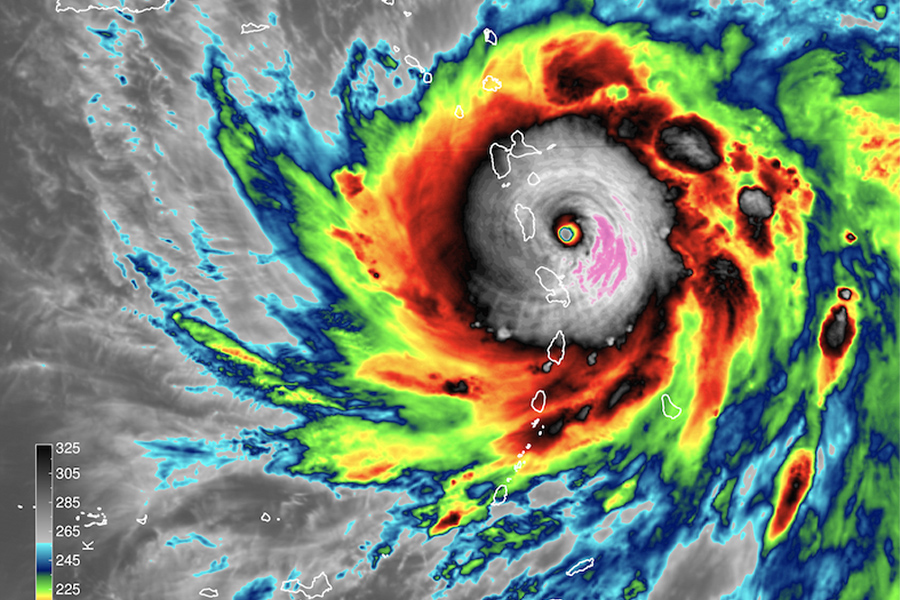
Better storm track prediction over the past few decades has allowed for timely preparation and evacuations but understanding how these storms form and intensify remains a challenge for scientists.
A Florida State University researcher was part of an international team studying the origin of tropical cyclones that found an infrared radiative feedback from clouds accelerates storm development. Deep clouds that are heavily laden with water droplets and ice crystals trap outgoing infrared radiation, creating a localized greenhouse effect that traps heat and warms the atmosphere in the area of the developing storm.
“This local warming causes rising motion in the storm, which helps fully saturate the atmosphere and increase inward flowing winds near the surface,” said Allison Wing, assistant professor in the FSU Department of Earth, Ocean, and Atmospheric Science. “This aids in the formation of a circulation near the surface that then strengthens and eventually forms a central eye, taking on the classic appearance of an intense tropical cyclone.”
The team’s work was published Oct. 26 in the Proceedings of the National Academy of Sciences of the United States of America.
Learning more about the transition from a tropical depression to an intensifying hurricane will improve scientists’ understanding of the processes that drive storm formation. To investigate tropical cyclone formation, the researchers looked at storms forming in the Atlantic and in the Western Pacific oceans and performed model simulations of two storms, 2013’s Super Typhoon Haiyan and 2017’s Hurricane Maria.

Researchers found the localized warming created by the cloud greenhouse effect helped accelerate the formation of both Haiyan and Maria. When they removed this effect in model simulations, the storms either formed more slowly or did not form at all.
Typically, there is a narrow window of time in which environmental conditions are favorable for storm development, so anything that helps the storm form more quickly increases the likelihood it will become an intense storm. The researchers argue the cloud greenhouse effect is therefore likely instrumental to the formation of many tropical storm events.
“Our results say this cloud radiative feedback is important for tropical cyclone development,” Wing said. “We know weather and climate models sometimes have a hard time simulating clouds correctly, which means this process is something we should study more closely as a possible avenue for much-needed hurricane forecast model improvement.”
While storm track forecasting has improved greatly over the last several decades, based on scientists’ ability to measure and predict the large-scale winds that control a storm’s path, there is still much to learn about storm formation.
“Our ultimate goal is to better forecast tropical cyclones, and it currently remains very hard to forecast storm formation,” said James H. Ruppert, Jr., assistant research professor of meteorology and atmospheric science at Penn State University and the study’s lead author. “The small-scale processes that govern storm formation and intensification in the first place, that is where our understanding and ability to observe are still really challenged.”
Wing has been investigating tropical cyclone development and, in particular, the role of cloud radiation feedback for several years and in a variety of settings — from idealized cloud-resolving model simulations to global climate models.
“When the opportunity arose to work with Dr. Ruppert to investigate this in realistic simulations of two historically intense storms, I was excited to contribute,” Wing said. “This topic is a theme of my ongoing research because our understanding of and ability to forecast tropical cyclone formation and intensification still has limitations. Further exploration into this cloud radiation feedback, newly identified by our study as important for real storms, has the potential to yield critical improvements in tropical cyclone prediction.”
Additional contributors to the project include Xiaodong Tang, associate professor, School of Atmospheric Sciences, Nanjing University, China; and Erika L. Duran, a researcher at the University of Alabama in Huntsville and the NASA Short-term Prediction Research and Transition (SPoRT) Center.
The project was supported by the National Oceanic and Atmospheric Administration, National Science Foundation, NASA, the National Key R&D Program of China, and National Natural Science Foundation of China.




